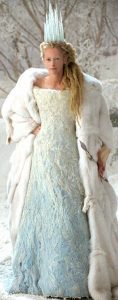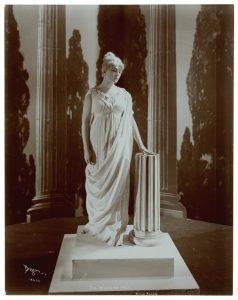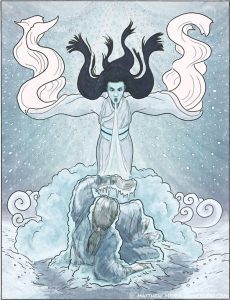 It may be warm out, but that makes it the perfect time to talk about winter – when we don’t have to experience it! We’ve talked about mermaids and bookish princesses, so this Folklore Friday feature is on snowy heroines and villains.
It may be warm out, but that makes it the perfect time to talk about winter – when we don’t have to experience it! We’ve talked about mermaids and bookish princesses, so this Folklore Friday feature is on snowy heroines and villains.

Disney’s Snow White
Photo Credit: Disney
There are many, of course. Snow White (originally written by Grimm and, as usual, famously adapted by Disney) escaped the dangers of being more beautiful than her stepmother by taking up homemaking with seven dwarves in the woods until a prince kisses her comatose form and saves her from poison. Hans Christian Andersen’s Snow Queenis of the imperious sort, but Frozen’s Queen

The White Witch of Narnia
Photo Credit: Narnia Wikia
Elsa struggles between her wild and frosty nature and social acceptance. The White Witch in Narniaturns enemies to stone and trapsthe land always in winter without celebrations. There doesn’t seem to be a consensus: sometimes winter personified signifies icy doom (winter is coming) and others it is innocence.
In Russia, Snegurochka, The Snow Maiden, appears in the 19th century. Alexander Afanasyev writes about The Snow Maiden in the second volume of The Poetic Outlook on Nature by the Slavs. She is a little doll made of snow by childless peasants, but she comes to life—only to evaporate when jumping over a fire with other children. She made an appearance in Andrew Lang’s The Pink Fairy Book, only to evaporate again. Snegurochka reappears as an icy young woman unable to love in Alexander Ostrovsky’s play (set to Tchaikovsky), only to melt when she falls in love and her heart warms up.

Viola Allen in The Winter’s Tale
Photo Credit: Folger Shakespeare Library
Generally it doesn’t turn out well for variations of Snegurochka; if she manages to survive, she loses immortality, but most of the time, the warmth to which she longs is her downfall.
Of course, if we’re talking about tales on winter, there’sShakespeare’s The Winter’s Tale (not at Shakespeare in the Park this year, but you can get his other seasonal play, A Midsummer Night’s Dream), which is a highly fantastical tale in which “Exit, pursued by a bear” comes out of nowhere. And, yes, (spoiler!) there’s a woman who may or may not become a statue for a number of years before she returns to life.

Yuki-onna
Photo Credit: Yokai
The ghostly Japanese Yuki-onna are female spirits connected with snow or the cold. These specters often feed on travelers lost in the winter or in cold regions of mountains,but sometimes fall in love with a human and live normal lives—aside from some incidental melting in the bath. This divide seems to be the common theme in winter folklore. Winter is sometimes a seemingly inescapable source of danger while other times it’s a perfectly guileless tragic figure. In summation, go enjoy the warmth while we have it!





Love it, and especially thoughts of snow and ice in hot summer.
Thanks Katherine!